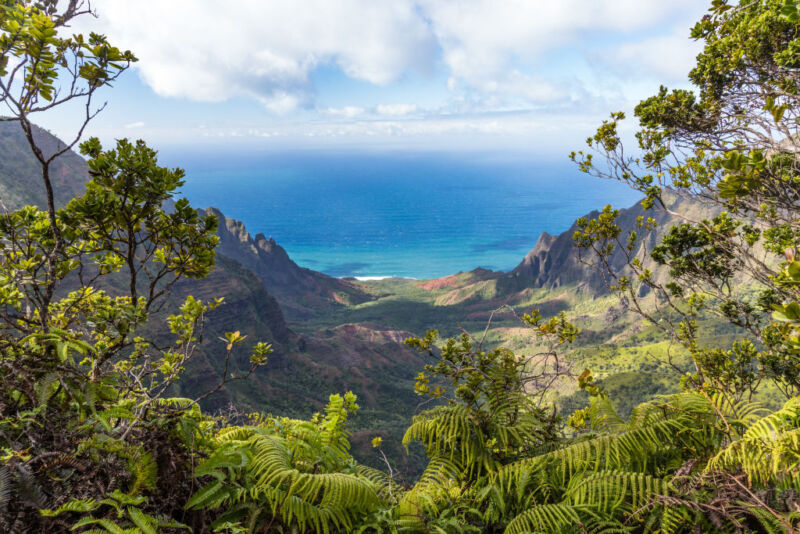Brutal —
First the Grand Canyon, now an eruption around the Grand Canyon of the Pacific.

Enlarge / The Kalalau Valley between sheer cliffs in the Na Pali Coast State Park on the western shore of the island of Kauai in Hawaii, United States. This view is from the Pihea Trail in the Kokee State Park.
The Hawaiian island of Kauai may not have any spewing lava, but hikers along the magnificent Napali coast have brought their own volcanic action recently, violently hollowing their innards amid the gushing waterfalls and deeply carved valleys.
Between August and early September, at least 50 hikers fell ill with norovirus along the famed Kalalau Trail, which has been closed since September 4 for a deep cleaning. The rugged 11-mile trail runs along the northwest coast of the island, giving adventurers breathtaking views of stunning sea cliffs and Kauai's lush valleys. It's situated just north of Waimea Canyon State Park, also known as the Grand Canyon of the Pacific.
"It’s one of the most beautiful places in the world. I feel really fortunate to be able to be there, and appreciate and respect that land,” one hiker who fell ill in late August told The Washington Post. "My guts exploding all over that land was not what I wanted to do at all."
That hiker, Danielle Burr, told the Post that she was one of at least eight people in her 12-member group to fall ill with vomiting and diarrhea after they had reached the Kalalau beach campsite, where the trail dead-ends at the foot of towering fluted ridges. After a night of relentless heaving outside of her tent, she was unable to make the 11-mile return trip and was taken to the hospital by helicopter just after sunrise.
"There was no way I could physically do that trail to get out," she said. "And I was spreading the virus all over the place, like, I'm a public health risk."
At first, responders assumed that some of the hikers had picked up leptospirosis, a bacterial infection that spreads from contaminated water and soil and is known to lurk along the trail. But, the brutal illness continued its lightning spread, with reports of other hikers along the trail erupting like biological volcanoes. Testing on September 5 determined that norovirus—a germ notorious for igniting explosive outbreaks in the great outdoors—was to blame.
Life’s a bleach
Let us all never forget the unsettling norovirus outbreak in the Grand Canyon in 2022, which had at least 222 hikers and rafters fiercely disgorging on the rims of the majestically sculpted basin. In March, the National Park Service warned that norovirus was likely behind a rash of illnesses along the Appalachian Trail in Georgia, Tennessee, and North Carolina.
You might remember that norovirus is a savage wilderness virus that is highly contagious and is generally unfazed by hand sanitizers. Any settings with large groups, limited clean water, and infrequent hand washing are prime norovirus territory. The virus spreads through the nauseating fecal-oral route. An infected person sheds billions of tiny viral particles in their stool, but it only takes a few particles transferring from hands, surfaces, or food to spark another infection. Once infected, a person typically develops diarrhea, vomiting, nausea, and stomach pain within 12 to 48 hours, with recovery following in one to three days.
On Kauai, park officials have cleared out the trail and are doing maintenance and cleaning. Derrick Louis of Hawaii's State Parks Division reported that employees are taking extra care to clean the Kalalau beach campsite's comfort station. "We swept the floor and bleached the whole bathroom, floors, railings, toilets, everything," he said. "Waited at least 7 to 10 minutes, cleaned everything, and did it again, and then we wiped everything down with a disinfectant."
The state's health department, meanwhile, released a survey for all recent visitors to the Napali Coast State Wilderness Park, which encompasses the Kalalau Trail, to identify additional cases and identify locations and activities linked to getting sick and not getting sick. The trail is scheduled to be closed at least until Thursday, September 19.